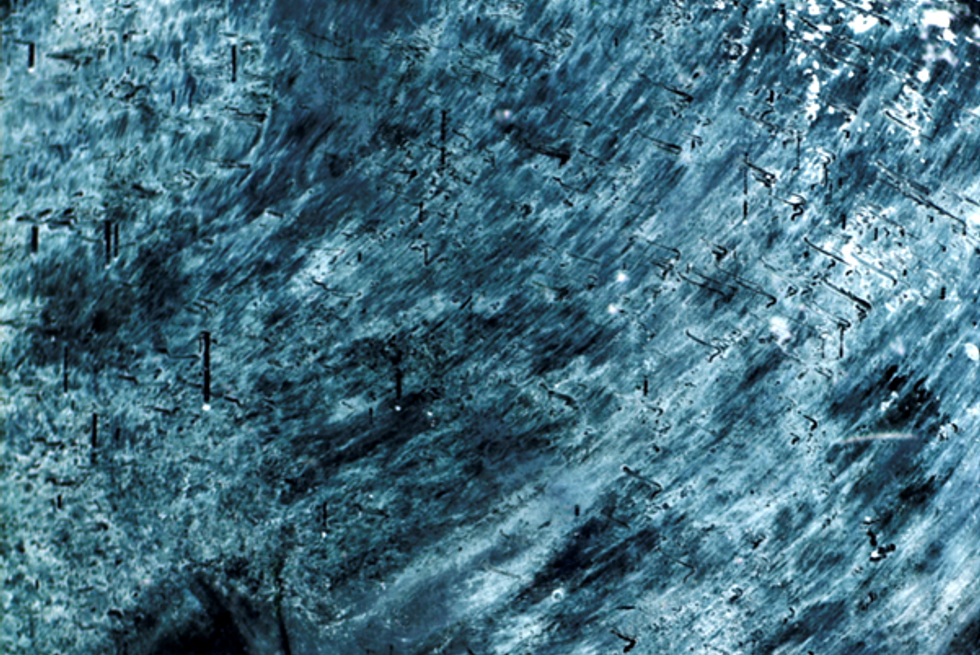Disintegration Stars
From the Series: In Whose Name?
From the Series: In Whose Name?

Disintegration Stars from Andrew Littlejohn on Vimeo.
It is well known that photography means writing with light. However, the meaning of “with” can be ambiguous. Does the photographer bend light to their will at the decisive moment when they open the shutter (Cartier-Bresson 2014)? Or does the light do the writing, forming impressions of itself “without the creative intervention of man,” as André Bazin and Hugh Gray once claimed (1960, 7)? The latter view might appear naïve after thirty years of critique regarding documentary media’s supposedly privileged relationship with reality (Balsom 2017). But even when mediated by human decision-making, photochemical processes remain ones where the agency of radioactive participles affect silver bromide in ways that a photographer can neither control nor fully anticipate. Unlike the forms of mediation that preceded it historically, photography is an art where the wanderings of light and other forms of radiation interact with other things—such as situated human subjects and their cameras—in a “dance of agency” (Pickering 2010).
However, film can be exposed outside of the camera. And historically, people have done so to render visible other forms of radiation than what we call light. In 1937, the physicists Marietta Blau and Hertha Wambacher traveled to a cosmic-ray observatory on Hafelekar, a mountain in Austria reaching 2,300 meters above sea level. They bore with them plates covered with a thick emulsion prepared specially by Ilford. Blau wanted to know if these plates could record charged particles passing through them, such as fast protons. She hoped that cosmic radiation made of exceptionally high-energy protons would leave tracks in the emulsion at such an altitude. When she returned to collect the plates four months later, she found this and more. They bore “dozens of ‘stars,’ each with several heavy tracks—from three to twelve—radiating from a central point” (Sime 2013, 10): stars whose unexpected presence settled the question of whether heavy nuclei disintegrated.
In mid-2013, I took several rolls of unexposed 16mm film to another location hoping to make radiation visible. This was a farm ten kilometers from the Fukushima Daiichi Nuclear Power Station, where two years previously several reactors melted down following a magnitude 9.1 earthquake and tsunami. Living in Fukushima afterward meant living with a constant presence one feared but could not see or feel. As a result, many people bought Geiger counters, hoping to transform “the presence of radioactive ions into a ‘reading’ that could register with bodily senses” (Weston 2017, 85). By burying film in the irradiated soil near the plant, I wanted to probe and make manifest the limits of visualization, the uneasy relationships between apparatuses and what they measure, and the anxieties of the nuclear age. I knew that bacteria living in the soil would eat the emulsion (there is, after all, a long tradition of burying film in experimental cinema). But I wondered if and perhaps hoped that I would see something—tracks, stars—indexing the presence of the “atomic light” (Lippit 2005) I feared.
After two weeks, I exhumed the film, selecting from it a single four-minute segment (which I scanned). I called it Disintegration Stars in homage to Blau. As the political and media anthropologist Veronika Kusumaryati wrote to me after watching it, “the results are horrifyingly beautiful and neat, resembling a long tradition of Japanese graphic arts. Every frame is a surface of pouring and dripping ink and lights: the unstable memories of soil, fading leaves, twigs, minerals, gases, liquids, unknown organisms, the darkness, the void, and the invisible.” When I first viewed the film, I wondered which parts of this were due to radiation, if any (and if I would ever be able to tell). Almost everybody I showed asked the same thing. Instead of overcoming the viewer’s epistemic uncertainty, the work seemed to amplify it—perhaps modeling, however partially, something of the experience of scanning an environment for a presence always beyond one’s senses.
In 2015, Eduardo Kohn asked if we could imagine an ontological poetics that “explore[s] modes of being ‘made over’ by realities not fully circumscribed by human worlds” and “cultivate[s] representational crafts that can amplify such transformations” (2015, 313). Disintegration Stars is one attempt to do so. It is the product of different entities—from bacteria to emulsion to possibly radioactive particles—entangling. Perhaps we could call this a form of uneasy collaboration in a world where not all entanglements are positive (Roberts 2017). However, the film itself—of which the scanned version presented here is just a replica, and thus removed from—works slightly differently from the representational forms Kohn writes of. In Devotional Cinema, Nathaniel Dorsky writes that “for alchemy to take place in a film, the form must include the expression of its own materiality, and this materiality must be in union with its subject matter” (2014, 24). Disintegration Stars tries to make us over through expressing its own uncertain materiality: a dance of agency in which we can never see where one dancer ends and another begins.
Balsom, Erika. 2017. “The Reality-Based Community.” E-Flux Journal #83.
Bazin, André, and Hugh Gray. 1960. “The Ontology of the Photographic Image.” Film Quarterly 13, no. 4: 4-9.
Cartier-Bresson, Henri. 2014. The Decisive Moment. Göttingen: Steidl.
Dorsky, Nathaniel. 2014. Devotional Cinema. Berkeley, CA: Tuumba Press.
Kohn, Eduardo. 2015. “Anthropology of Ontologies.” Annual Review of Anthropology 44, no. 1: 311-327.
Lippit, Akira Mizuta. 2005. Atomic Light (Shadow Optics). Minneapolis: University of Minnesota Press.
Pickering, Andrew. 2010. "Material Culture and the Dance of Agency." In The Oxford Handbook of Material Culture Studies, edited by Dan Hicks and Mary C. Beaudry, 191-208. Oxford: Oxford University Press.
Roberts, Elizabeth. 2017. “What Gets Inside: Violent Entanglements and Toxic Boundaries in Mexico City.” Cultural Anthropology 32, no. 4: 592-619.
Sime, Ruth Lewin. 2013. “Marietta Blau: Pioneer of Photographic Nuclear Emulsions and Particle Physics.” Physics in Perspective 15, no. 1: 3-32.
Weston, Kath. 2017. Animate Planet: Making Sense of Living in a High-Tech Ecologically Damaged World. Durham, NC: Duke University Press.